ROCHESTER, N.Y., June 7, 2007 -- Precision flat-surfaced optics fabricator Sydor Optics has built its reputation on the solid foundation of traditional craftsmanship provided by its founder, Stefan Sydor, coupled with gutsy innovations implemented by his son, Jim.
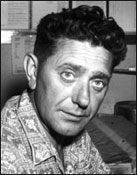 |
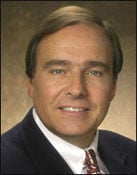 |
|
Stefan Sydor
|
Jim Sydor
|
Stefan Sydor, a pioneer in the field of optics/fabrication, was known for his passion for optics and his ability to meet optical challenges with unique solutions. He was at the forefront of the optical experts of his generation. Stefan began his career as an optician at Eastman Kodak Co. in the 1930s. His skills were such that Kodak "loaned" him out to projects requiring an expert optician, such as the Mt. Palomar Observatory, where he helped do the mirror's final figuring, and the Baker-Nunn Satellite Tracking Camera for The Smithsonian Astrophysical Observatory in the early 1960s.
"He could make anything out of a piece of glass," said company manager Michael Naselaris.
The success of those projects helped give Stefan the confidence, in 1964 at the age of 50, to start his own company, Sydor Optics.
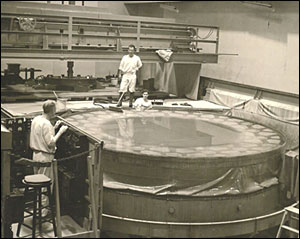
Stefan Sydor was one of the opticians doing the final figuring on the Mt. Palomar Observatory. (Photos courtesy Sydor Optics)
Stefan took a very hands-on, practical approach to managing his company and displayed the frugality common in those of his generation. He maintained a garden at Sydor's Rochester headquarters for years, and often the only light that could be seen shining in the building after dark would be in the room where Stefan was working late into the night.
Stefan's son, Jim, joined the company in the late 1970s after receiving an optics tech degree and gaining experience by working for two other optics companies. Jim began running Sydor's daily operations in the late 1980s, and in the 1990s (Stefan died in 1992) made the gutsy decision to move away from lens manufacturing and into the company's current specialties, precision flat-surfaced parallel and wedged optics and double-sided grinding and polishing, while maintaining the passion for quality, attention to detail and excellent customer service that was his father's legacy.
That decision has turned out to be a very good one for Sydor, which has seen rapid growth over the past few years.
"We have grown by a factor of six in the last 10 years," said Naselaris. "The last three years have been record growth for us each year. Right now, we're just trying to stabilize a little bit, focusing on increasing capacity and capabilities."
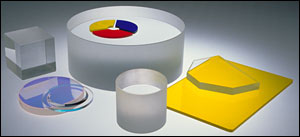
Precision flat-surfaced parallel optics is Sydor's specialty.
Sydor Optics, which had nine workers in 1997, now employs 39, and last year shipped over 200,000 parts. Sales now top $6 million annually. Its recent success has meant adding a second shift for increasing capacity in the double-sided grinding and polishing operations area of the company, which accounts for approximately 75 percent of the optics produced.
Sydor Optics has more double-sided machines working glass than anyone else in the US. The company's precision flat-surfaced parallel and wedged optics, such as beamsplitters, colored glass filters, debris shields for high-energy lasers, glass wafers and windows, serve a diverse customer base.
About 20 percent of Sydor's customers are in the semiconductor industry. Other top industries the company serves include aerospace, cinematography, medical, military, photolithography and telecommunications. National laboratories are also big customers, with Lawrence Livermore National Lab in Livermore, Calif., being the biggest.
"One of our missions is to keep customers as happy as we can. You have to not give them a reason to look somewhere else. If you are not helping your customers be more successful, someone else will. We service about 150 customers a year, with about 80 of them as repeat customers that we always have orders for," Naselaris said.
Sydor produces 8000 to 10,000 color filters each year for use in cinematography, as well as others with military or spectroscopy applications. Double-sided grinding and polishing is its specialty, and Sydor supplies optical components for an ever-increasing number of applications and industries, including display technologies, microlithography, optoelectronics and astronomy.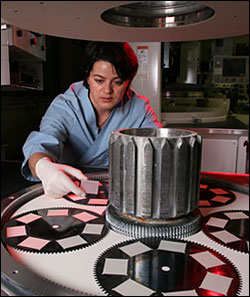
An optician loads a double-sided polisher.
While the photonics industry in the entire Rochester area is booming these days, nowhere is that more evident than at Sydor Optics.
In the fall of 2003 the company added a second location, six miles away in Fairport, N.Y., for grinding and polishing calcium fluoride and magnesium fluoride optics. "We do those parts in volume, everything from making the blank to grinding and polishing parts," Naselaris said.
"In the summer of 2004, we started another company, Sydor Instruments -- Jim started it with Michael J. Pavia, president of the company -- and its main product is the ROSS (Rochester Optical Streak System) streak camera," he said. "They have a close connection with the University of Rochester, from where the technology for the streak camera was licensed. As items are developed there, they try to commercialize them," he said.
Things are going so well for Sydor Optics that this month the company is relocating into a new headquarters eight miles from its present location, making Sydor a company that is literally "on the move."
Through all innovations and new product offerings, though, Sydor doesn't lose sight of the fact that its employees are a large part of its success.
"Really, it's just a building with equipment. It's the people that make things happen. Anyone can get a loan from the bank and buy the equipment, but that doesn't make 'em the company they are. It's like a big family here," Naselaris said. There is not a lot of turn over, and many of Sydor's employees have been there for 10 years or more.
The company attributes its success to several things: high-quality products, referrals from customers, and, perhaps most importantly, the solid foundation provided by Stefan Sydor.
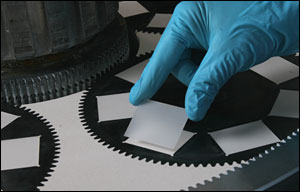
Thin parts at 0.20-mm thick are placed into polishing carriers on the double-sided polisher at Sydor Optics.
Sydor Optics specializes in precision flat-surfaced optics and double-sided grinding and polishing (up to 450-mm diameter, with conventional grinding and polishing on diameters up to 1000 mm). From prototype and specialty quantities to large-volume OEM production, its products are manufactured with strict attention to customer specifications and time frame.
"Very few businesses specialize in double-sided, they just do it in addition to what they normally do," said Naselaris.
"We're focusing on increasing capacities and capabilities. Over time technology is making things smaller and thinner yet larger in volume. Requests for glass wafers are going larger in diameter yet thickness is getting much thinner," he said.
Whether the optics being fabricated are for a small business, a national lab or a multimillion-dollar Hollywood production like the movie "Titanic," Sydor Optics' customers all get first-class service.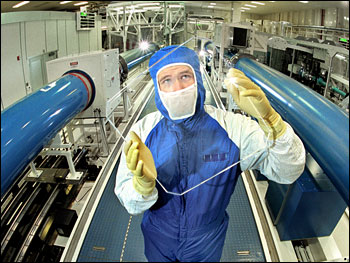
One of the products Sydor makes is debris shields for lasers, such as this one for Z-Beamlet, a large aperture, high-energy laser at Sandia National Laboratory in Albuquerque, N.M., used to radiograph experiments at the adjacent Z accelerator facility.
"Once we had filters that had to go to Paris," for a film, Naselaris said. "It was such a rush order that we worked on them in the morning and got them out on the next flight out of Rochester later that day. Another time a customer flew in from California with the optics on his lap. We worked on them within minutes of his arrival and sent him back to California the next morning.
"It doesn't happen that often, but you do get rush jobs like that from time to time," he said.
The ability to meet customers' needs, high-quality products and attention to detail all make Sydor Optics attractive as a vendor.
"Coating companies tend to be our largest customers," Naselaris said. "Most people will go to a coating company and say, 'I want a finished part, I don't want to go buy the optic somewhere and have you do the coating,' and so we sell to coating companies quite a bit."
The company's experience working as a vendor also helps when dealing with its own general material suppliers and coating vendors.
"We're real thankful because of the suppliers we've got. We have vendors who jump through hoops for us," Naselaris said.
Although welcome, the rapid growth the company has experienced over the past few years has meant a few growing pains.
"We have some equipment in the parking lot, because we didn't have room in the building." Naselaris said. "This equipment is used a few times a year, and is moved into the building, taking the place of another piece of equipment, when it needs to be used. The new building has room for everything and even some room for additional equipment as we grow."
The company is relocating the offices of two of its operations into the new headquarters on June 21, and moving the production side of the businesses there on June 25.
"And even though we bought a larger building, it's still not big enough, so we're adding on to it. So by fall, all three locations will be in the same building, with some additional room for growth," Naselaris said.
The new building, purchased right after Photonics West 2007, is 38,000 sq ft and is about eight miles from the old location. Right after the closing, Sydor began to remodel it in preparation for moving both Sydor Optics and Sydor Instruments there, as well as adding another 12,000 sq ft to move the calcium and magnesium fluoride operations into the building this fall. That will give the company an extra 6000 sq ft for future growth and to devote to special projects.
"We have larger projects we're working on that repeat from year to year, and sometimes they need more space and equipment, and we'd like to have the room to dedicate to it," Naselaris said.
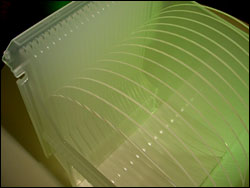
Glass wafers used for photonics chips, small filters and wire-grid polarizers.
One such long-term project is making glass wafers for diffractive optics -- photonics chips for coating companies that coat and dice them into smaller filters.
"Right now our biggest wafer project involves televisions, where one of our customers puts a wire-grid polarizer on them and dices them and they get shipped to Japan and put in Sony rear-projection televisions," he said. The company is also involved in aircraft head-up display projects for the military.
The numerous companies working in optics in the Rochester area have become a powerful team, jokingly referred to as the "Glass Cartel" that help each other and work together to promote upstate New York as one-stop shopping for optics.
"We have some local friends who will just walk in the shop and take something off the shelf and tell us on the way out, 'I'll replace it in a few days.' Maybe their equipment broke down, or they needed the added capacity or capability. They aren't just competitors, they are our friends.
"I came from an automotive background, and that's very cut-throat. And seeing what the optics community is like, it was a very welcome change -- it was tremendous," Naselaris said.
Jim Sydor works tirelessly to promote the Rochester optics community and the field of optics. He serves as exhibit cochair of Optifab, SPIE's optical fabrication trade show; is president of APOMA (the American Precision Optics Manufacturers Association) and serves on the boards of the Rochester Region Photonics Cluster and the New York State Photonics Industry Association. He also speaks at local schools and universities to get students interested in optics careers.
At Sydor Optics, the expertise and attention to detail necessary to produce high-precision optics is paired with craftsmanship and the latest optical fabrication technology. This has made Sydor Optics the vendor of choice for companies whose needs range from prototype to large-volume production, from highly complex to cost-efficient components, all manufactured to the same exacting standard of excellence. The company's commitment to outstanding customer service is evident in its record of consistent quality and on-time delivery.
At Stefan Sydor Optics, the past and the present form a powerful partnership to build the future.
For more information, visit: www.sydor.com; e-mail: [email protected]
Sydor Optics
31 Jet View Dr.
Rochester, NY 14624
Phone: (585) 271-7300
Fax: (585) 271-7309
